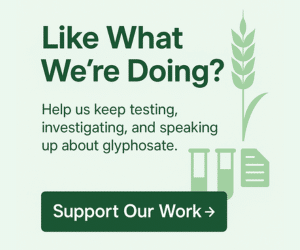When the European Union re-approved glyphosate in late 2017, industry headlines celebrated it as a victory for “science.”
The message was simple: after exhaustive review, Europe’s regulators had concluded glyphosate was safe.
But behind the scenes, something was very wrong. Reports soon surfaced that key parts of the official assessment — the very text regulators used to justify re-approval — had been copied and pasted directly from Monsanto’s own submissions. At the same time, leaked internal documents revealed that Monsanto scientists had ghost-written supposedly “independent” papers that regulators relied on.
This wasn’t just about toxicology or statistics. It was about trust. How can the public believe assurances of safety when the watchdog is borrowing pages straight from the playbook of the company on trial?
The German “Copy-Paste” Scandal
Under the EU’s pesticide rules, one country is assigned as the Rapporteur Member State to prepare the first draft of a renewal assessment. For glyphosate, that responsibility fell to Germany’s Federal Institute for Risk Assessment (BfR). Their job was to independently review the science and submit a Renewal Assessment Report for peer review by the European Food Safety Authority (EFSA) and other Member States.
Instead, investigations revealed that large portions of BfR’s draft were copied almost word-for-word from documents provided by the European Glyphosate Task Force — a consortium of agrochemical companies led by Monsanto. Journalists, NGOs, and even a European Parliament-commissioned study confirmed the striking similarities.
The problem wasn’t just sloppy work. By repeating industry conclusions rather than critically evaluating the evidence, BfR blurred the line between independent assessment and corporate advocacy. As one researcher put it, this amounted to “significant scientific misconduct.”
When the referee borrows the playbook from the team under review, how can the public be expected to trust the final score?
Ghostwritten Science in the Glyphosate Debate
The scandal didn’t stop at copy-paste. The Monsanto Papers — thousands of internal emails and memos released in U.S. litigation — showed how company staff secretly ghost-wrote academic papers that downplayed glyphosate’s risks.
In one instance, Monsanto employees drafted large sections of a 2000 review article that was later published under the names of supposedly independent scientists. In another, they strategized about how to “keep Monsanto in the background” while providing talking points to academic allies.
These ghostwritten papers were then cited by regulators as independent evidence of glyphosate’s safety. It was a perfect loop: industry writes the paper, regulators cite the paper, industry claims the science is settled.
What looks like robust consensus can, under scrutiny, turn out to be manufactured doubt.
Infiltration and the Revolving Door
Critics also point to the structural conflicts of interest in EU scientific committees. Some panel members had past or ongoing ties to industry groups. Others moved between regulator jobs and agrochemical companies — the classic “revolving door.”
An academic review by toxicologist David Novotny summed it up starkly: four major issues corrupt the regulatory process — lack of independence, revolving doors, covert influence by industry, and over-reliance on confidential, unpublished studies submitted by companies themselves.
The end result? Even when procedures are technically followed, the system is skewed toward the applicant’s perspective.
Why This Matters Beyond Europe
The EU is often seen as a “gold standard” in chemical regulation. Smaller countries, including New Zealand, lean heavily on EU assessments to justify their own positions.
But if Europe’s glyphosate process was compromised by copy-paste assessments, ghostwriting, and industry infiltration, then basing our policies on those conclusions is shaky ground.
It raises a simple but uncomfortable question: are New Zealand regulators truly evaluating glyphosate independently, or just recycling compromised overseas conclusions?
The Myth of Certainty
Industry spokespeople like to reassure the public with lines such as: “Glyphosate has been thoroughly reviewed and found safe.” It sounds final, objective, unassailable.
But that’s the myth. The reality is more complicated. When independent watchdogs outsource their analysis to the companies under review, the claim of certainty collapses.
This doesn’t mean glyphosate has been proven to cause harm in every instance. But it does mean that the regulatory foundation for “safe” claims is riddled with cracks. If the process is broken, the conclusions cannot command full trust.
And once public trust is lost, no amount of PR spin can rebuild it.
Where This Leaves Us
This isn’t just about glyphosate. It’s about the integrity of our regulatory systems. If committees can be swayed, if reports can be ghost-written, if conflict of interest is brushed aside, then what confidence can we have in the rules meant to protect us?
The glyphosate saga in Europe shows how industry influence can muddy the waters and create uncertainty — not by accident, but by design. When regulators are seen to serve industry rather than the public, it is democracy itself that suffers.
New Zealand consumers, councils, and farmers deserve better. We deserve independent, transparent, precautionary reviews, not recycled corporate text. If we cannot trust the process, how can we trust the product?
Resources & References
The debate over glyphosate is often framed as a clash of scientific evidence, yet the story is also about who controls the evidence and how it is presented. Below are key investigations, reports, and books that shed light on the ghostwriting, copy-paste assessments, and regulatory conflicts that have tilted the debate. These resources don’t just provide background — they reveal the deeper fault lines in a system we’re told to trust.
The Monsanto Papers: Deadly Secrets, Corporate Corruption, and One Man’s Search for Justice
Investigative journalist Carey Gillam exposes how industry reached into the courtroom, the lab and the regulatory corridors — ghost-written research, secret memos and a groundskeeper who took on a global giant. A must-read for anyone seeking to understand how corporate strategies shaped the glyphosate debate.
EU glyphosate approval was based on plagiarised Monsanto text, report finds
The Guardian (2019)
A major investigative piece showing that the lead regulatory dossier for glyphosate in the EU (the Renewal Assessment Report by Bundesinstitut für Risikobewertung — BfR) contains large blocks of text lifted verbatim from industry-submissions (notably by the European Glyphosate Task Force, backed by Monsanto). This raised alarms about independence and integrity of the EU risk assessment.
Detailed Expert Report on Plagiarism and superordinated Copy Paste in the RAR on Glyphosate
European Parliament (2018)
A detailed expert-analysis commissioned in part via the European Parliament that compared the BfR’s docket with the industry-applicant text and found up to ~90 % similarity in some chapters. The report concluded that the independence of the assessment was compromised.
Decades of Deceit: How Corporate Influence Has Manipulated Science and Safety Assessments on Glyphosate
U.S. Right to Know (2017)
Carey Gillam’s Presentation to the European Parliament
Investigative journalist Carey Gillam presented to a joint hearing of the European Parliament in October 2017, drawing on the so-called “Monsanto Papers” (internal Monsanto / Bayer documents) to demonstrate how industry ghost-wrote papers, influenced scientists and regulators, and shaped the glyphosate narrative.
The Great Glyphosate Court Case
PAN (Pesticide Action Network) Europe
PAN Europe’s webpage describing their legal challenge to the EU re-approval of glyphosate. They frame it as a case of corporate influence subverting the precautionary principle, and argue that the risk assessment process failed in transparency, independence and rigor.
Glyphosate, Roundup and the Failures of Regulatory Assessment
By Eva Novotny (2022, Toxics)
An academic review that examines the structural problems in the regulatory system for glyphosate in Europe and the United States: over-reliance on industry studies, ignoring independent peer-reviewed literature, revolving-door conflicts of interest, and the failure to assess formulations rather than just the active ingredient. The paper supplies a strong overview of how process flaws amplify scientific uncertainty.
Taken together, these sources highlight a recurring theme: when corporate interests seep into scientific assessments, the line between evidence and advocacy blurs. That’s why asking better questions — about independence, transparency, and integrity — matters just as much as asking about toxicity levels or risk thresholds. If the process itself is compromised, then so too are the assurances built upon it.
Image Source & Attribution
We’re grateful to the talented photographers and designers whose work enhances our content. The feature image on this page is by cooperr007.




